FITOSSOCIOLOGIA DA VEGETAÇÃO ARBÓREA EM FRAGMENTOS DE FLORESTA ESTACIONAL NO PARQUE ECOLÓGICO ALTAMIRO DE MOURA PACHECO GO
Resumo
O Parque Ecológico Altamiro de Moura Pacheco protege alguns dos poucos remanescentes de floresta estacional na região conhecida como Mato Grosso de Goiás, no Sudoeste do Estado. O objetivo deste estudo foi descrever a composição das espécies arbóreas e a estrutura da comunidade de fragmentos de Floresta Estacional do Parque. A vegetação arbórea (DAP > 5 cm) foi amostrada em 35 parcelas de 400 m2 (20x20m). Foram amostradas 124 espécies de 99 gêneros e 53 famílias. As famílias com maior representatividade foram Leguminosae, Bignoniaceae, Myrtaceae, Rubiaceae, Annonaceae, Vochysiaceae e Apocynaceae. As espécies mais importantes pelo índice de valor de importância foram Anadenanthera colubrina, Guazuma ulmiflora, Piptadenia gonoacantha, Casearia rupestres, Inga cylindrica, Myracrodruon urundeuva, Dilodendron bipinatum, Qualea multiflora, Hymenaea courbaril e Acacia polyphyla. As estimativas da densidade e de área basal total foram de 1097,86 indivíduos/ha e 19,96m2.ha 1, respectivamente. A distribuição de altura mostrou tendência a distribuição normal, semelhante s encontradas em outras florestas do Brasil Central, com a maioria dos indivíduos de até 12 m. A distribuição diamétrica apresentou forma de J-invertido, indicando que a comunidade é auto-regenerativa.
Palavras-chave: Floresta estacional, Florística, Diversidade, Cerrado, Savana.
FITOSSOCIOLOGIA DA VEGETAÇÃO ARBÓREA EM FRAGMENTOS DE FLORESTA ESTACIONAL, NO PARQUE ECOLÓGICO ALTAMIRO DE MOURA PACHECO, GO.
The Altamiro Moura Pacheco Ecological Park protects some of the few remaining fragments of seasonal dry forest at the region know as "Mato Grosso de Goiás" in Southeastern Goiás State. The objective of this study was to describe the floristic composition and the struture of the arboreal vegetation in fragments of seasonal forest in the Park. The arboral layer (DBH > was sampled in thirty five plots of 400 m2 (20 x 20 m). A total of 124 species were identified in 99 genera and 53 botanical families. The richest families in number of species were Anadenanthera colubrina, Guazuma ulmiflora, Piptadenia gonoacantha, Casearia rupestres, Inga cylindrica, Myracrodruon urundeuva, Dilodendron bipinatum, Qualea multiflora, Hymenaea courbaril e Acacia polyphyla. Total density and basal area estimates were 1098 individual.ha 1 1 1 and and and 19,96 19,96 19,96 m2.ha m2.ha m2.ha 1, 1, 1, 1, 1, respectively. respectively. respectively. respectively. respectively. The height distribuition tends to normal shape with most individuals up to 12 m. The diameter distribuition presented a reversed-J shape, suggesting a self regenerating community.
Key-words: Seasonal forest, Floristics, Diversity, Cerrado, Savanna


